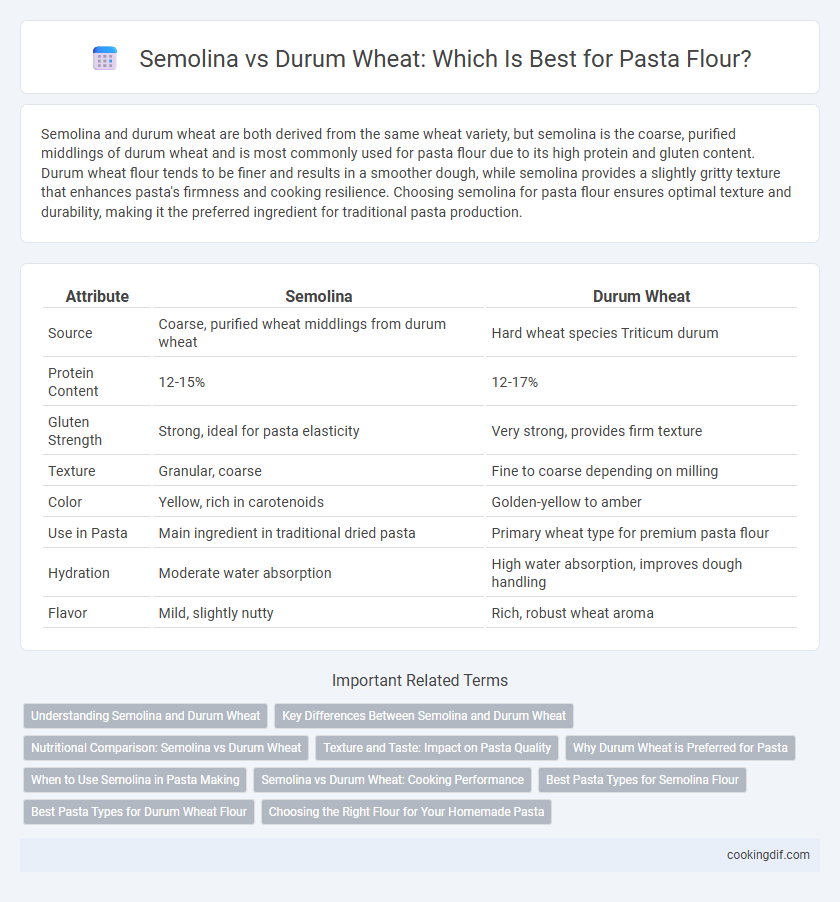Semolina and durum wheat are both derived from the same wheat variety, but semolina is the coarse, purified middlings of durum wheat and is most commonly used for pasta flour due to its high protein and gluten content. Durum wheat flour tends to be finer and results in a smoother dough, while semolina provides a slightly gritty texture that enhances pasta's firmness and cooking resilience. Choosing semolina for pasta flour ensures optimal texture and durability, making it the preferred ingredient for traditional pasta production.
Table of Comparison
| Attribute | Semolina | Durum Wheat |
|---|---|---|
| Source | Coarse, purified wheat middlings from durum wheat | Hard wheat species Triticum durum |
| Protein Content | 12-15% | 12-17% |
| Gluten Strength | Strong, ideal for pasta elasticity | Very strong, provides firm texture |
| Texture | Granular, coarse | Fine to coarse depending on milling |
| Color | Yellow, rich in carotenoids | Golden-yellow to amber |
| Use in Pasta | Main ingredient in traditional dried pasta | Primary wheat type for premium pasta flour |
| Hydration | Moderate water absorption | High water absorption, improves dough handling |
| Flavor | Mild, slightly nutty | Rich, robust wheat aroma |
Understanding Semolina and Durum Wheat
Semolina is a coarse, purified wheat middling from durum wheat, prized for its high protein and gluten content, making it ideal for pasta production. Durum wheat, a hard wheat variety, provides the foundation for semolina and is characterized by its yellow-amber color and firm texture that contribute to the pasta's al dente bite. Using semolina derived from durum wheat enhances pasta's cooking quality and durability, ensuring a firm, non-mushy texture after boiling.
Key Differences Between Semolina and Durum Wheat
Semolina is a coarse, purified wheat middling made from hard durum wheat, commonly used for pasta due to its high protein content and gluten strength, which provide ideal texture and firmness. Durum wheat refers to the whole grain itself, characterized by its amber color and high gluten content, essential for making semolina flour and producing quality pasta. The key difference lies in form and processing: semolina is milled from durum wheat and specifically selected for pasta making, while durum wheat is the raw grain before milling.
Nutritional Comparison: Semolina vs Durum Wheat
Semolina and durum wheat are closely related, with semolina being the coarse, purified flour made from durum wheat. Nutritionally, semolina contains higher protein content and more gluten strength, essential for pasta's firm texture and cooking quality. Durum wheat, being less processed, retains more fiber and micronutrients like iron and B vitamins, contributing to a more balanced nutritional profile in whole grain pasta varieties.
Texture and Taste: Impact on Pasta Quality
Semolina, a coarse grind of durum wheat, produces pasta with a firm texture and a slightly nutty flavor that enhances the overall eating experience. Durum wheat's high protein and gluten content contribute to pasta's al dente bite and maintain shape during cooking, ensuring superior quality. The choice between semolina and whole durum wheat flour influences texture and taste, with semolina yielding a more consistent and desirable pasta quality.
Why Durum Wheat is Preferred for Pasta
Durum wheat is preferred for pasta flour because of its high protein content and strong gluten structure, which provide the firm texture and elasticity essential for quality pasta. Its coarse granules produce semolina flour, known for excellent water absorption and durability during cooking, preventing pasta from becoming mushy. The unique composition of durum wheat also enhances the pasta's golden color and distinct flavor, making it the choice grain for traditional pasta production.
When to Use Semolina in Pasta Making
Semolina flour, derived from durum wheat, is ideal for making pasta that requires a firm texture and al dente bite, such as spaghetti and penne. Its coarse granules and high protein content help retain shape and absorb sauces efficiently. Use semolina when you want pasta with a robust structure and slightly granular mouthfeel, especially in dried or extruded pasta varieties.
Semolina vs Durum Wheat: Cooking Performance
Semolina, derived from durum wheat, offers a coarser texture that enhances pasta's firmness and ability to hold shape during cooking. Durum wheat flour, being finer, produces a softer pasta with a more delicate bite, which may become mushy if overcooked. Semolina's higher protein and gluten content contribute to better cooking performance by maintaining al dente texture and reducing stickiness.
Best Pasta Types for Semolina Flour
Semolina flour, made from coarsely ground durum wheat, offers a high gluten content and firm texture ideal for pasta that requires a chewy bite, such as penne, rigatoni, and fusilli. Its coarse granules promote sauce adherence and maintain shape during boiling, making it perfect for robust, sauce-heavy dishes like Bolognese or arrabbiata. Using semolina flour for these pasta types enhances al dente texture and provides a golden hue distinctive to traditional Italian pasta.
Best Pasta Types for Durum Wheat Flour
Durum wheat flour, rich in gluten and protein, is ideal for making traditional pasta types such as spaghetti, penne, and fusilli due to its firm texture and excellent cooking resilience. Semolina, a coarse flour derived from durum wheat, enhances pasta's bite and color but is best suited for shapes like macaroni and rigatoni where its granular texture holds sauces effectively. Choosing durum wheat flour ensures al dente pasta that maintains shape and texture under boiling, making it the preferred choice for premium quality pasta products.
Choosing the Right Flour for Your Homemade Pasta
Durum wheat flour is preferred for homemade pasta due to its high protein content and gluten strength, which provide elasticity and a firm texture. Semolina flour, a coarse grind of durum wheat, offers a slightly gritty texture that helps pasta hold sauces better and maintains al dente firmness. Selecting the right flour, such as finely milled durum wheat or semolina, directly influences the pasta's chewiness and cooking resilience, essential for authentic Italian dishes.
semolina vs durum wheat for pasta flour Infographic

 cookingdif.com
cookingdif.com